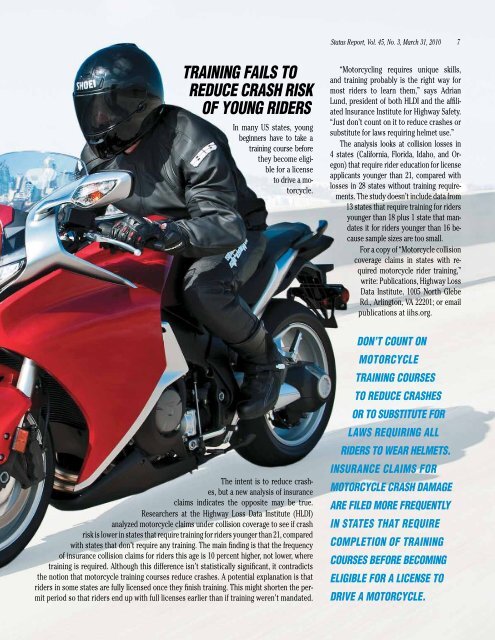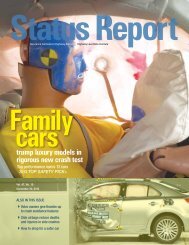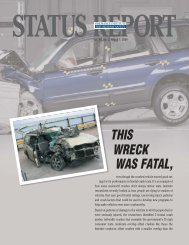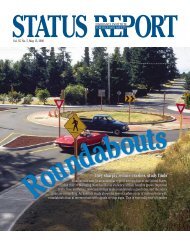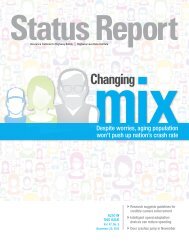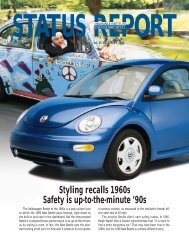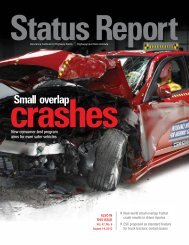6 <strong>Status</strong> <strong>Report</strong>, <strong>Vol</strong>. <strong>45</strong>, <strong>No</strong>. 3, <strong>March</strong> <strong>31</strong>, <strong>2010</strong>642ANTILOCK BRAKESON MOTORCYCLESprevent crashesThe best motorcycle crash is the one thatnever happens. One technology designedto reduce the chance of crashing is antilockbraking. The Institute first reported on theeffectiveness of motorcycle antilocks in2008 (see <strong>Status</strong> <strong>Report</strong>, Oct. 22, 2008; on theweb at iihs.org). <strong>No</strong>w 2 new studies, one bythe Institute and one by the affiliated HighwayLoss Data Institute (HLDI), providemore evidence that antilocks reduce fatalcrash risk and lower insurance losses.Stopping a motorcycle is trickier thanstopping a car. For one thing, the front andrear wheels typically have separate brakecontrols. In an emergency, a rider faces asplit-second choice to either brake hard,fatal crashesper 10,000 motorcycle registratIONS,WITH AND WITHOUT ANTILOCKS, 2003-08withoutantilockswithoutwithantilocks antilockswithantilocks0-10-20ple. But the new studies indicate that antilocksreduce crashes overall and save lives.Institute researchers compared the fatalcrash experience of antilock-equipped motorcyclesagainst their nonantilock counterpartsduring 2003-08. The main findingis that motorcycles with antilocks versuswithout are 37 percent less likely to be infatal crashes per 10,000 registered vehicleyears. Bolstering this finding is a separateHLDI analysis of insurance claims filed fordamage to motorcycles. Bike models withantilocks have 22 percent fewer claims fordamage per insured vehicle year than thesame models without antilocks.Drivers younger than 25 have the highestestimated claim frequencies. Wheremotorcyclists ride also affects claims. Thefrequency of claims for crash damage tobikes is 9 percent higher in urban areas withheavy traffic than in moderately congestedinsurance claimspercent reductIONS in collISION lOSSesfor 2003-08 MODelS with antilocks0-10-20claimfrequencyclaimfrequency severityoverall claimseverity losseswhich can lock the wheels and cause anoverturn, or hold back on braking and riskrunning headlong into the emergency. This iswhen antilocks can help by reducing brakepressure when they detect impending lockupand then increasing the pressure again whentraction is restored. Brake pressure is evaluatedmultiple times per second, so ridersmay brake fully without fear of locking up.Antilocks won’t prevent every motorcyclecrash. They won’t help a rider who’sabout to be struck from behind, for examlocales.There were 13 percent fewer claimsin the least populated areas than in mediumdensity ones. The effects of antilocks onclaims were estimated only after controllingfor these and other factors.Antilocks are gaining traction among motorcyclemanufacturers and wider acceptanceamong riders. More than half of motorcycleowners recently surveyed by the Institutesaid they’d get antilocks on their next bike.Buyers can find them now on at least 60 newmodels (go to iihs.org for a list).overalllosses“Motorcycle antilocks do make a difference,”says Institute president Adrian Lund,who also is president of HLDI. “They helpmake traveling on 2 wheels less risky by reducingthe chance of overturning a bike andcrashing. Passenger vehicles still are safer,but if you’re going to ride we’d recommendgetting a motorcycle with antilocks.”HLDI also looked at injury claims.Under medical paymentcoverage, motorcycleswith antilocksregistered 30 percentlower claim frequenciesthan bikeswithout this feature.Claim frequencies were33 percent lower underbodily injury liabilitycoverage.Institute researchersused data from the federalFatality Analysis<strong>Report</strong>ing System and motorcycleregistration recordsfrom R. L. Polk andCompany. HLDI provided antilockfeature informationfrom its proprietary databaseof vehicle features.For a copy of “Effectivenessof antilockbraking systems inreducing motorcyclefatal crashrates” by E.R.Teoh or a HLDIspecial reporton motorcycleantilockbraking systems,write:Publications,<strong>Insurance</strong> Institutefor HighwaySafety, 1005<strong>No</strong>rth Glebe Rd.,Arlington,VA22201; or emailpublications@iihs.org.
<strong>Status</strong> <strong>Report</strong>, <strong>Vol</strong>. <strong>45</strong>, <strong>No</strong>. 3, <strong>March</strong> <strong>31</strong>, <strong>2010</strong> 7TRAINING FAILS TOreduce crash riskOF young ridersIn many US states, youngbeginners have to take atraining course beforethey become eligiblefor a licenseto drive a motorcycle.“Motorcycling requires unique skills,and training probably is the right way formost riders to learn them,” says AdrianLund, president of both HLDI and the affiliated<strong>Insurance</strong> Institute for Highway Safety.“Just don’t count on it to reduce crashes orsubstitute for laws requiring helmet use.”The analysis looks at collision losses in4 states (California, Florida, Idaho, and Oregon)that require rider education for licenseapplicants younger than 21, compared withlosses in 28 states without training requirements.The study doesn’t include data from13 states that require training for ridersyounger than 18 plus 1 state that mandatesit for riders younger than 16 becausesample sizes are too small.For a copy of “Motorcycle collisioncoverage claims in states with requiredmotorcycle rider training,”write: Publications, Highway LossData Institute, 1005 <strong>No</strong>rth GlebeRd., Arlington, VA 22201; or emailpublications at iihs.org.The intent is to reduce crashes,but a new analysis of insuranceclaims indicates the opposite may be true.Researchers at the Highway Loss Data Institute (HLDI)analyzed motorcycle claims under collision coverage to see if crashrisk is lower in states that require training for riders younger than 21, comparedwith states that don’t require any training. The main finding is that the frequencyof insurance collision claims for riders this age is 10 percent higher, not lower, wheretraining is required. Although this difference isn’t statistically significant, it contradictsthe notion that motorcycle training courses reduce crashes. A potential explanation is thatriders in some states are fully licensed once they finish training. This might shorten the permitperiod so that riders end up with full licenses earlier than if training weren’t mandated.DON’T COUNT ONmotorcycleTRAINING COURSESTO REDUCE CRASHESOR TO substitute forLAWS REQuiring allriders TO Wear helmets.insurance claims formotorcycle crash damageare filed more freQuentlyIN states that REQuirecomPletion OF trainingcourses before becomingELIGIBLE FOR A LICENSE TODRIVE A MOTORCYCLE.


